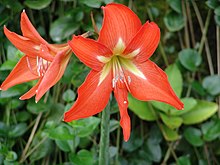Hippeastrum
| Hippeastrum | |
|---|---|
 |
|
| Hippeastrum reginae | |
| Scientific classification | |
| Kingdom: | Plantae |
| Clade: | Angiosperms |
| Clade: | Monocots |
| Order: | Asparagales |
| Family: | Amaryllidaceae |
| Subfamily: | Amaryllidoideae |
| Subtribe: | Hippeastrinae |
| Genus: |
Hippeastrum Herb. |
| Type species | |
|
Hippeastrum reginae (L.) Herb. |
|
| Subgenera | |
| Synonyms | |
Hippeastrum /ˌhɪpiːˈæstrəm/ is a genus of about 90 species and over 600 hybrids and cultivars of perennial herbaceous bulbous plants. They generally have large fleshy bulbs and tall broad leaves, generally evergreen, and large red or purple flowers.
Hippeastrum is a genus in the family Amaryllidaceae (subfamily Amaryllidoideae, tribe Hippeastreae, and subtribe Hippeastrineae) The name Hippeastrum, given to it by William Herbert, means "Knight's-star-lily", although precisely what Herbert meant by the name is not certain. For many years there was confusion among botanists over the generic names Amaryllis and Hippeastrum, one result of which is that the common name "amaryllis" is mainly used for cultivars of this genus, often sold as indoor flowering bulbs particularly at Christmas in the northern hemisphere. By contrast the generic name Amaryllis applies to bulbs from South Africa, usually grown outdoors. The genus is native to tropical and subtropical regions of the Americas from Argentina north to Mexico and the Caribbean.
...
Wikipedia
